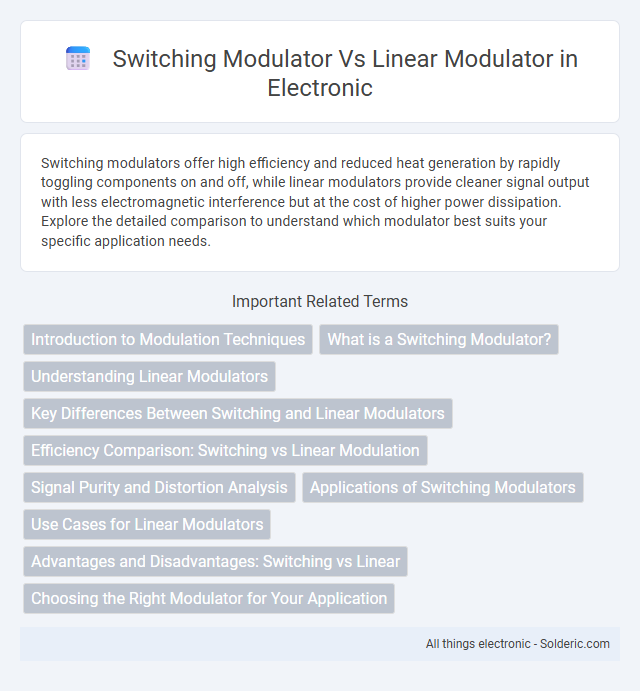Switching modulators offer high efficiency and reduced heat generation by rapidly toggling components on and off, while linear modulators provide cleaner signal output with less electromagnetic interference but at the cost of higher power dissipation. Explore the detailed comparison to understand which modulator best suits your specific application needs.
Comparison Table
| Feature | Switching Modulator | Linear Modulator |
|---|---|---|
| Operation | Uses high-frequency switching to regulate output | Uses linear control element to regulate output continuously |
| Efficiency | High (80%-95%) | Low (30%-60%) |
| Heat Dissipation | Minimal; less heat generated | Significant heat generated, requires heat sinks |
| Complexity | More complex circuitry | Simple circuitry |
| Signal Quality | Possible switching noise, requires filtering | High-quality, low noise output |
| Size | Smaller size due to efficient design | Larger size due to heat sinks |
| Cost | Higher due to complexity | Lower cost |
| Applications | Radio transmitters, power-efficient systems | Audio amplification, precision analog circuits |
Introduction to Modulation Techniques
Switching modulators operate by rapidly turning the output devices on and off, resulting in high efficiency and reduced heat dissipation, making them ideal for power-sensitive applications. Linear modulators regulate output by continuously varying the conduction of their active devices, delivering precise signal control with low distortion but at the cost of lower efficiency. Understanding these modulation techniques enables you to select the appropriate modulator based on the trade-offs between power efficiency and signal fidelity.
What is a Switching Modulator?
A switching modulator is a power-efficient device that controls output voltage by rapidly switching a transistor on and off, minimizing energy loss compared to linear modulators. It utilizes pulse-width modulation (PWM) to regulate the duty cycle, allowing precise control of power delivered to the load. Your choice of a switching modulator can significantly improve efficiency in applications requiring high power conversion with reduced heat dissipation.
Understanding Linear Modulators
Linear modulators provide high-fidelity signal amplification by continuously varying the output transistor's conduction in direct proportion to the input signal, resulting in minimal distortion and accurate waveform reproduction. This approach is ideal for applications requiring precise modulation such as RF transmitters, where signal integrity and linearity are paramount. Understanding linear modulators helps you select the optimal modulation method for systems demanding low noise and high linearity performance.
Key Differences Between Switching and Linear Modulators
Switching modulators operate by rapidly toggling the output device between on and off states, achieving high efficiency and minimal heat dissipation, while linear modulators control output by continuously varying the device's conduction, resulting in greater heat generation and lower efficiency. Switching modulators excel in power-sensitive applications due to their superior efficiency, whereas linear modulators provide superior signal linearity and lower electromagnetic interference, making them ideal for precision applications. Your choice depends on the trade-off between efficiency and signal quality, with switching modulators preferred for power efficiency and linear modulators favored for high fidelity.
Efficiency Comparison: Switching vs Linear Modulation
Switching modulators achieve efficiency levels typically above 80-90% due to their operation in saturation or cutoff modes, minimizing power loss by rapidly switching transistors on and off. Linear modulators generally exhibit lower efficiencies, around 30-60%, because they continuously operate in their active region, dissipating significant power as heat. The higher efficiency of switching modulators makes them preferred for applications requiring power conservation and thermal management.
Signal Purity and Distortion Analysis
Switching modulators offer high efficiency but can introduce switching noise and harmonic distortion, potentially impacting signal purity. Linear modulators provide superior signal fidelity with minimal distortion, making them ideal for applications where maintaining low noise and high linearity is critical. Your choice depends on balancing efficiency needs against the requirements for clean, distortion-free signal output.
Applications of Switching Modulators
Switching modulators are widely used in high-power RF applications such as radar systems, wireless base stations, and broadcast transmitters due to their high efficiency and ability to handle large voltage swings. They are ideal for pulsed and complex modulation schemes including digital communication signals where power conservation and heat dissipation are critical factors. Switching modulators also find applications in industrial heating and medical devices, where precise energy control and reliability are essential.
Use Cases for Linear Modulators
Linear modulators excel in applications requiring low noise and high signal fidelity, such as high-precision audio amplification and sensitive analog signal processing. They are ideal for laboratory equipment, RF communication systems, and instrumentation where minimal distortion and rapid response to signal variations are critical. Despite lower efficiency compared to switching modulators, their ability to maintain signal integrity makes them indispensable in telecommunications and medical devices.
Advantages and Disadvantages: Switching vs Linear
Switching modulators offer higher efficiency, often exceeding 80%, due to their ability to rapidly toggle between on and off states, which minimizes power loss and heat generation compared to linear modulators. Linear modulators provide superior signal fidelity and lower output noise, making them ideal for applications requiring precise analog modulation but suffer from lower efficiency, typically around 30-50%, causing increased thermal dissipation. The trade-off involves switching modulators excelling in power savings and compact design while linear modulators prioritize signal accuracy and simplicity, influencing the choice based on application-specific requirements.
Choosing the Right Modulator for Your Application
Switching modulators offer high efficiency and compact design, making them ideal for battery-powered and heat-sensitive applications, whereas linear modulators provide superior signal fidelity and lower electromagnetic interference, suitable for precision analog circuits. Choice depends on specific requirements: prioritize efficiency and power conservation with switching modulators, or select linear modulators for applications demanding minimal signal distortion. Understanding the trade-offs in thermal management, noise performance, and power handling ensures optimal modulation performance tailored to your system's needs.
Switching modulator vs linear modulator Infographic

 solderic.com
solderic.com